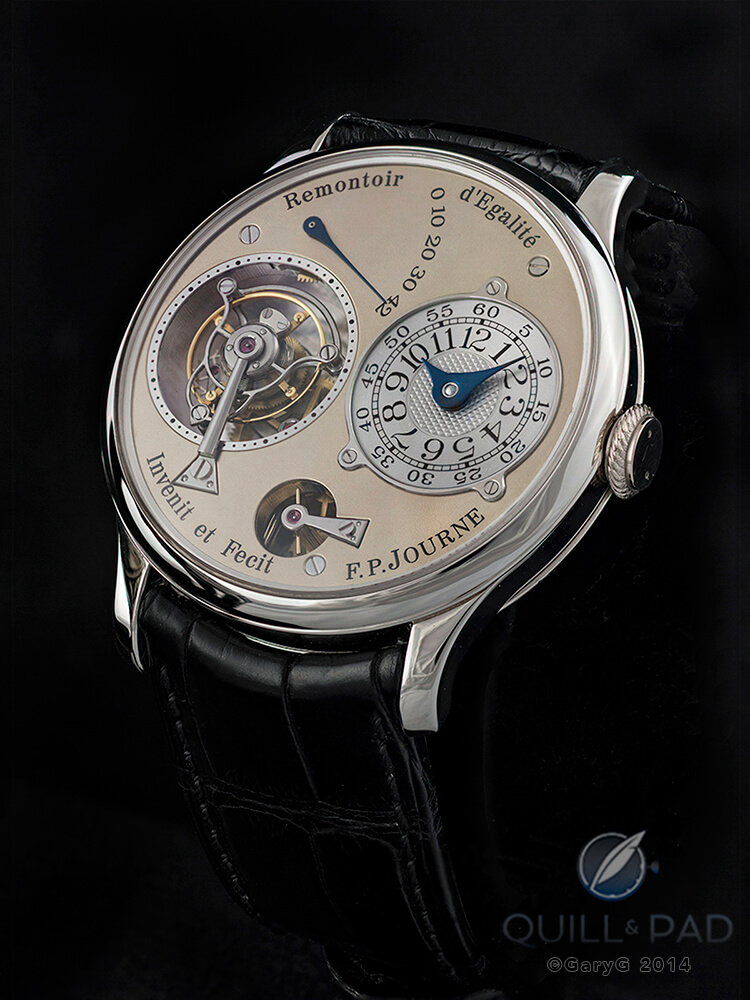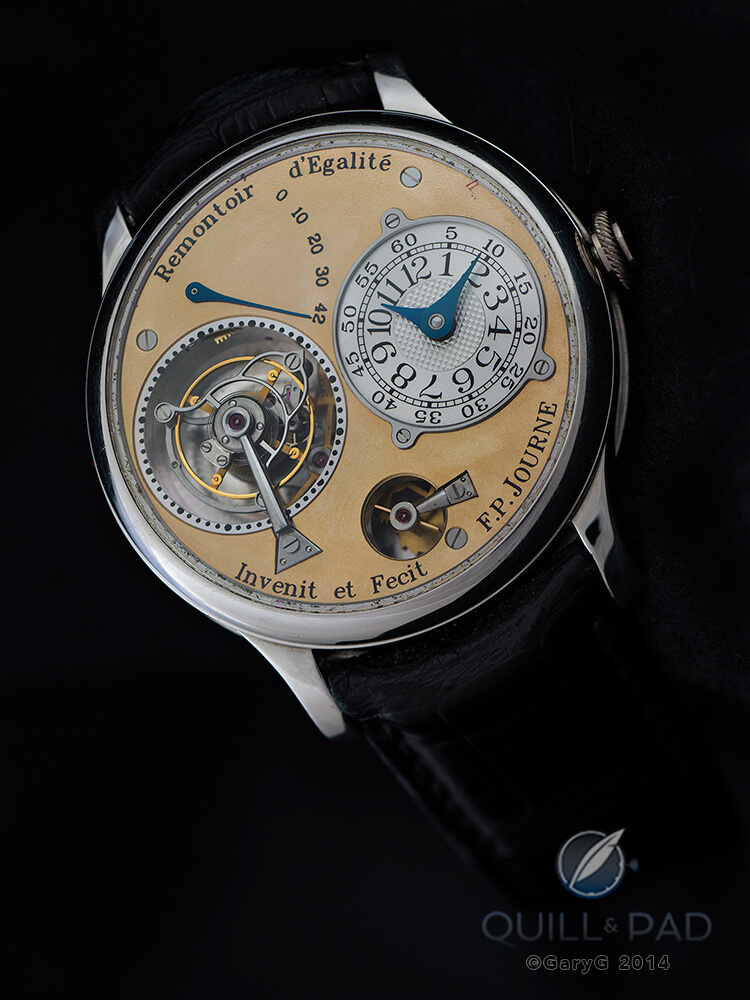by GaryG
One of the great advantages of belonging to the relatively close-knit community of watch collectors is that one has the opportunity to see a lot of great watches.
Even the small group of enthusiasts that I hang out with on a regular basis collectively owns a significant assortment of some of the greatest watches I know – and as they are generous fellows, I have fairly regular opportunities to see, try on, and photograph some of these fantastic pieces.
That’s great for me because like many watch enthusiasts, I’ve also gone a bit nuts about photography. Specifically, macro photography, which at my relatively modest level of competence provides an opportunity to hunch over a camera and light tent for hours on end, fiddling with camera, lens, and watches, hoping that at least a few of the resulting images will justify the stiff neck and strained eyes.
There is now a payoff, though: from time to time, as part of my “enthusiast collector” role here at Quill & Pad I will be taking a look at watches that strike my fancy, and sharing the visual results with you along with a few observations on photography, the watches themselves, and the collectors who own them.
Let’s get started, shall we? Our subject for this episode: the F.P. Journe Tourbillon Souverain with remontoir d’égalité.
My photography mentor, the outrageously talented Ming Thein, sets out four elements required for a good image: light, subject, composition, and story.
Regardless of what you think of the lighting and composition of this first shot, I hope that you will agree that the subject is a doozy! The Tourbillon Souverain was the first model sold by Mr. Journe’s eponymous enterprise, F.P Journe. In addition to its technical sophistication, it set the basis for the visual style and design cues that are characteristic of Journe’s watches to this day.
Many directly noticeable visual elements tell us that this is a Journe watch well before we see his name or read the Invenit et Fecit motto on the dial.
These include the use of silvered subdials with screw-mounted steel frames; the fonts; the ornate appearance of the main subdial with its explicit labeling of hours and minutes, railroad track, and guilloche center; the shapes of the hands and bridges; and even the characteristic crown with its rope edge motif.
There is an inherent risk to getting into watch photography as a watch enthusiast: mixing the two hobbies puts you at a serious peril of buying watches when you weren’t planning to do so! In this instance, a friend of mine asked whether I would take a few pictures of his Journe tourbillon so that he could post the watch for sale.
I happily took him up on his offer, but then something entirely predictable happened: I could not put this one down. He did (or didn’t, depending on your point of view) help by encouraging me to “feel free to keep it and wear it around for a while.”
Suffice it to say that one thing led to another, and now this piece occupies a place of pride in my own collection. Perhaps I’ll return to this watch here on Quill & Pad at some later time and provide a full review that sets out all of its virtues as I see them.
But for now, I’ll just call your attention to the white gold dial and its beautiful color. These early white gold dials from Journe have a tone I haven’t seen anywhere else – almost a champagne color – that I could stare at for hours and that, for me, is the ideal complement to the crisper appearance of the platinum case.
If this watch is so great, you ask, why in the world was my pal selling his? As it turns out, he had just bought the one shown below.
Wait a minute – isn’t that the same watch? Well, yes and no! Of course, it is also an early Tourbillon Souverain, in fact, even earlier in the series than mine. The most obvious difference is the yellow gold dial, and not just any yellow, but a striking, deep yellow that is to many an even more appealing hue than my “champagne” dial.
It is a dial greatly prized by Journe collectors. Due to the reflectivity of the dial, it’s very difficult to capture its true essence – but perhaps this next shot will give you a sense.
Despite the apparent similarity of the two watches, there are also several other subtle differences between them that enthusiasts discuss and debate. Take a look at the side-by-side image below and see how many you can spot.

Two F.P. Journe Tourbillon Souverain models with remontoir d’égalité; the slightly earlier model is at left
I may actually miss one or two myself, but based on both research and personal observation, I’d say that in comparison to my watch, the yellow-dialed one is different in the following ways:
The word “Remontoir” is slightly closer to 12 o’clock. Also, the font of the term “Remontoir d’Egalité” also appears to be very slightly different than that on the white gold-dialed watch. Among other things, if you look very carefully you can see that the apostrophe is curved on my friend’s watch and straight on mine.
- It has a different, smaller font for the power reserve indicator.
- It uses much larger, and somewhat more rustic, dots for the seconds on the ring surrounding the opening for the tourbillon.
- There is a poising hole in the tourbillon cage itself (you can just see it if you look at the spot on the cage just to the left of the 16-second mark on the surrounding ring).
- It has an beveled edge around the remontoir bridge opening (the round hole at 6 o’clock) as opposed to a rounded edge on the same hole on my watch.
- The remontoir cock (that small one-arm bridge at 6 o’clock) has a curved, rather than flat, upper surface.
- The word “Invenit” is positioned slightly toward the outside edge of the dial, but this could just be a byproduct of the hand-printing technique utilized.
- The time (hours/minutes) subdial appears brighter. This may be an optical illusion given the different luminosities of the main dials of the two watches, or may be a function of a coating added to the subdial of my watch during its recent full service, as I haven’t read about this particular color difference in any of my research.
- There are more items on this list than one would expect, I suppose. On later watches in this same series, there were even more changes – small and large – including the thickness of the small blade of the remontoir mechanism at 6 o’clock, the diameter of the screws fixing the dial to the movement, and most importantly, the color and patina of the main dials.
The differences between the two watches were important enough to my friend that he jumped at the chance to make the switch, and at the end of the day both he and I are pleased as punch. This, to me, helps to illustrate why the term “enthusiast collector” has meaning: it refers to someone who has the passion to learn and care about the distinctions that separate an appealing watch from one that is “just right” for him or her. Not to mention the conviction to put his or her hard-earned money behind that passion.
If you’ve been looking at the photos carefully – and if you’ve gotten this far I am guessing that you have – you have already learned one important fact about watch photography: the macro lens (especially when coupled with a high-resolution camera like my Nikon D800E) is a harsh mistress.
Woe be unto her or him who prior to shooting does not invest the time needed to clean the watch thoroughly, as each speck of dust will look like a boulder and any stray threads seem to take on the size of those ropes they use to tie up ocean liners.
As we look at my buddy’s new pride and joy, we can clearly see that it is in need of a full service – lots of crumbled adhesive inside the crystal around its edge (and even some sort of red thread that has worked its way in there), dirty, spent oils on many of the steel surfaces, pitting on the hands, uneven patina on the main dial, scratches on the case, and so on.
Happily, as my “new” watch shows, Journe does a great job reconditioning watches to near-original form, so I’m looking forward to seeing (and photographing) the yellow-dialed watch once it returns from its trip to Geneva.
So, which one is it for you?
For more information, please visit fpjourne.com/eu/collections-en-sln-1.
This post was originally published on May 20, 2014 at Behind The Lens: The F.P. Journe Tourbillon Souverain.
Quick Facts F.P. Journe Tourbillon Souverain
Case: platinum or red gold, 38 mm
Movement: manually wound Caliber 1498 with constant force regulated by remontoir d’égalité
Functions: hours, minutes, seconds (on tourbillon cage); power reserve indicator
Price: originally ca. $120,000 in platinum, recent auction sale prices vary between $70,000 and $95,000 (including buyer’s premium)
Production years: 1999 through 2004
Remark: this model was later replaced by the Tourbillon Souverain with remontoir and deadbeat seconds (still in production) powered by Caliber 1403 with 18-karat gold plates and bridges; available in 38 and 40 mm platinum and red gold cases





























































Leave a Reply
Want to join the discussion?Feel free to contribute!